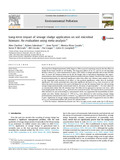JavaScript is disabled for your browser. Some features of this site may not work without it.
| dc.contributor.author | Charlton, Alex | |
| dc.contributor.author | Sakrabani, Ruben | |
| dc.contributor.author | Tyrrel, Sean F. | |
| dc.contributor.author | Rivas Casado, Monica | |
| dc.contributor.author | McGrath, Steve P. | |
| dc.contributor.author | Crooks, Bill | |
| dc.contributor.author | Cooper, Pat | |
| dc.contributor.author | Campbell, Colin D. | |
| dc.date.accessioned | 2016-08-17T12:48:39Z | |
| dc.date.available | 2016-08-17T12:48:39Z | |
| dc.date.issued | 2016-08-04 | |
| dc.identifier.citation | Charlton A, Sakrabani R, Tyrrel S, et al., (2016) Long-term impact of sewage sludge application on soil microbial biomass: An evaluation using meta-analysis. Environmental Pollution, Volume 219, December 2016, pp1021-1035 | en_UK |
| dc.identifier.issn | 0269-7491 | |
| dc.identifier.uri | http://dx.doi.org/10.1016/j.envpol.2016.07.050 | |
| dc.identifier.uri | http://dspace.lib.cranfield.ac.uk/handle/1826/10337 | |
| dc.description.abstract | The Long-Term Sludge Experiments (LTSE) began in 1994 as part of continuing research into the effects of sludge-borne heavy metals on soil fertility. The long-term effects of Zn, Cu, and Cd on soil microbial biomass carbon (Cmic) were monitored for 8 years (1997-2005) in sludge amended soils at nine UK field sites. To assess the statutory limits set by the UK Sludge (Use in Agriculture) Regulations the experimental data has been reviewed using the statistical methods of meta-analysis. Previous LTSE studies have focused predominantly on statistical significance rather than effect size, whereas meta-analysis focuses on the magnitude and direction of an effect, i.e. the practical significance, rather than its statistical significance. The results presented here show that significant decreases in Cmic have occurred in soils where the total concentrations of Zn and Cu fall below the current UK statutory limits. For soils receiving sewage sludge predominantly contaminated with Zn, decreases of approximately 7–11% were observed at concentrations below the UK statutory limit. The effect of Zn appeared to increase over time, with increasingly greater decreases in Cmic observed over a period of 8 years. This may be due to an interactive effect between Zn and confounding Cu contamination which has augmented the bioavailability of these metals over time. Similar decreases (7–12%) in Cmic were observed in soils receiving sewage sludge predominantly contaminated with Cu; however, Cmic appeared to show of recovery after a period of 6 years. Application of sewage sludge predominantly contaminated with Cd appeared to have no effect on Cmic at concentrations below the current UK statutory limit. | en_UK |
| dc.language.iso | en | en_UK |
| dc.publisher | Elsevier | en_UK |
| dc.rights | Attribution 4.0 International | en_UK |
| dc.rights.uri | http://creativecommons.org/licenses/by/4.0/ | |
| dc.subject | Sewage sludge | en_UK |
| dc.subject | Microbial biomass carbon | en_UK |
| dc.subject | Heavy metals | en_UK |
| dc.subject | Meta-analysis | en_UK |
| dc.title | Long-term impact of sewage sludge application on soil microbial biomass: An evaluation using meta-analysis | en_UK |
| dc.type | Article | en_UK |
Files in this item
This item appears in the following Collection(s)
-
Staff publications (SWEE) [2824]

